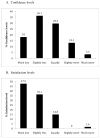Primary care providers' views on chronic pain management among high-risk patients in safety net settings
- PMID: 22846057
- PMCID: PMC3443261
- DOI: 10.1111/j.1526-4637.2012.01443.x
Primary care providers' views on chronic pain management among high-risk patients in safety net settings
Abstract
Objective: We examined chronic pain management practices and confidence and satisfaction levels in treating chronic pain among primary care providers (PCPs) who cared for high-risk patients in safety net health settings.
Design: We recruited PCPs (N = 61) through their HIV-infected patients who were enrolled in a longitudinal study on pain, use, and misuse of opioid analgesics (Pain Study). We asked PCPs to complete a questionnaire about all of their patients in their practice on the prevalence of chronic pain and illicit substance use, use of opioid analgesics, confidence and satisfaction levels in treating chronic pain, and likelihood of prescribing opioid analgesics in response to clinical vignettes.
Results: All PCPs cared for at least some patients with chronic pain, and the majority prescribed opioid analgesics for its treatment. All PCPs cared for at least some patients who used illicit substances. PCPs reported low confidence and satisfaction levels in treating chronic pain. The majority (73.8%) of PCPs were highly likely to prescribe opioid analgesics to a patient without a history of substance use who had chronic pain. The majority (88.5%) were somewhat to highly likely to prescribe opioid analgesics to a patient with a prior history of substance use but not active use. Most (67.2%) were somewhat to highly likely to prescribe opioids to a patient with active substance use.
Conclusion: In order to improve PCPs' confidence and satisfaction in managing chronic pain, further work should explore the root causes of low confidence and satisfaction and also explore possible remedies.
Wiley Periodicals, Inc.
Conflict of interest statement
Conflict of Interest
None disclosed
Figures
Similar articles
-
Evaluation of Primary Care Physician Chronic Pain Management Practice Patterns.Pain Physician. 2018 Nov;21(6):E593-E602. Pain Physician. 2018. PMID: 30508990
-
Primary care providers’ judgments of opioid analgesic misuse in a community-based cohort of HIV-infected indigent adults.J Gen Intern Med. 2011 Apr;26(4):412-8. doi: 10.1007/s11606-010-1555-y. J Gen Intern Med. 2011. PMID: 21061084 Free PMC article.
-
Acceptability of Naloxone Co-Prescription Among Primary Care Providers Treating Patients on Long-Term Opioid Therapy for Pain.J Gen Intern Med. 2017 Mar;32(3):291-295. doi: 10.1007/s11606-016-3911-z. Epub 2016 Nov 4. J Gen Intern Med. 2017. PMID: 27815762 Free PMC article.
-
How to Maximize Patient Safety When Prescribing Opioids.PM R. 2015 Nov;7(11 Suppl):S225-S235. doi: 10.1016/j.pmrj.2015.08.016. PM R. 2015. PMID: 26568502 Review.
-
Role of primary care physicians in intrathecal pain management: a narrative review of the literature.Postgrad Med. 2018 May;130(4):411-419. doi: 10.1080/00325481.2018.1448207. Epub 2018 Mar 28. Postgrad Med. 2018. PMID: 29542370 Review.
Cited by
-
Examining Racial/Ethnic Differences in Patterns of Opioid Prescribing: Results from an Urban Safety-Net Healthcare System.J Racial Ethn Health Disparities. 2024 Apr;11(2):719-729. doi: 10.1007/s40615-023-01555-z. Epub 2023 Mar 9. J Racial Ethn Health Disparities. 2024. PMID: 36892815 Free PMC article.
-
Factors Associated with Pain Treatment Satisfaction Among Patients with Chronic Non-Cancer Pain and Substance Use.J Am Board Fam Med. 2021 Nov-Dec;34(6):1082-1095. doi: 10.3122/jabfm.2021.06.210214. J Am Board Fam Med. 2021. PMID: 34772764 Free PMC article.
-
Provider confidence in opioid prescribing and chronic pain management: results of the Opioid Therapy Provider Survey.J Pain Res. 2017 Jun 7;10:1395-1400. doi: 10.2147/JPR.S136478. eCollection 2017. J Pain Res. 2017. PMID: 28652805 Free PMC article.
-
Can we not work together to help family practitioners become more effective pain managers?J Pain Res. 2016 Oct 13;9:803-806. doi: 10.2147/JPR.S121505. eCollection 2016. J Pain Res. 2016. PMID: 27785094 Free PMC article. No abstract available.
-
Improving the Delivery of Chronic Opioid Therapy Among People Living With Human Immunodeficiency Virus: A Cluster Randomized Clinical Trial.Clin Infect Dis. 2021 Oct 5;73(7):e2052-e2058. doi: 10.1093/cid/ciaa1025. Clin Infect Dis. 2021. PMID: 32697847 Free PMC article. Clinical Trial.
References
-
- Martell BA, O’Connor PG, Kerns RD, Becker WC, Morales KH, Kosten TR, Fiellin DA. Systematic review: opioid treatment for chronic back pain: prevalence, efficacy, and association with addiction. Ann Intern Med. 2007;146:116–27. - PubMed
-
- Turk DC, Swanson KS, Gatchel RJ. Predicting opioid misuse by chronic pain patients: a systematic review and literature synthesis. Clin J Pain. 2008;24:497–508. - PubMed
-
- Gilson AM, Ryan KM, Joranson DE, Dahl JL. A reassessment of trends in the medical use and abuse of opioid analgesics and implications for diversion control: 1997–2002. J Pain Symptom Manage. 2004;28:176–88. - PubMed
-
- Starrels JL, Becker WC, Alford DP, Kapoor A, Williams AR, Turner BJ. Systematic review: treatment agreements and urine drug testing to reduce opioid misuse in patients with chronic pain. Ann Intern Med. 2010;152:712–20. - PubMed
Publication types
MeSH terms
Substances
Grants and funding
LinkOut - more resources
Full Text Sources
Medical


